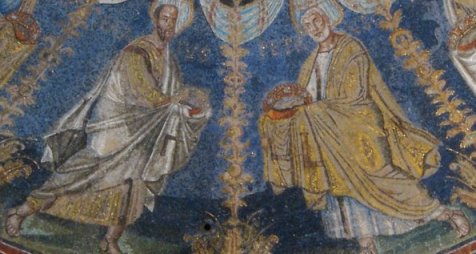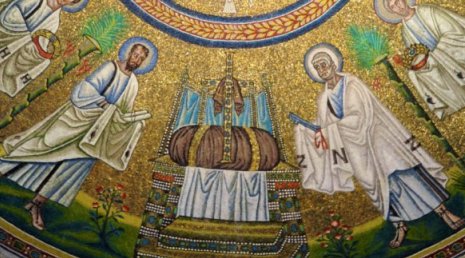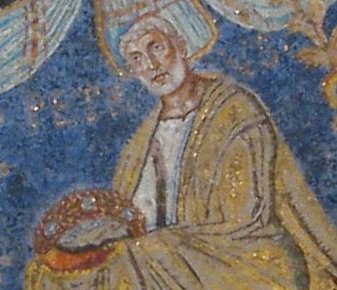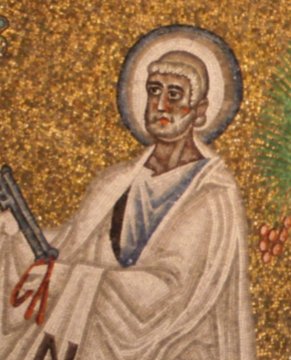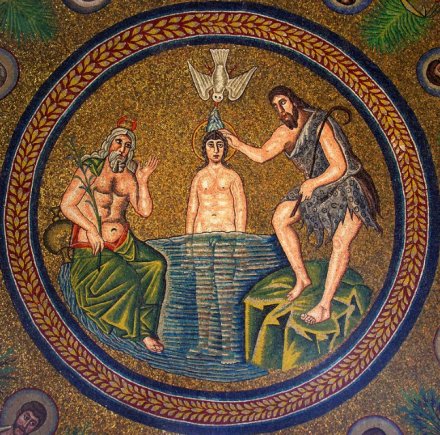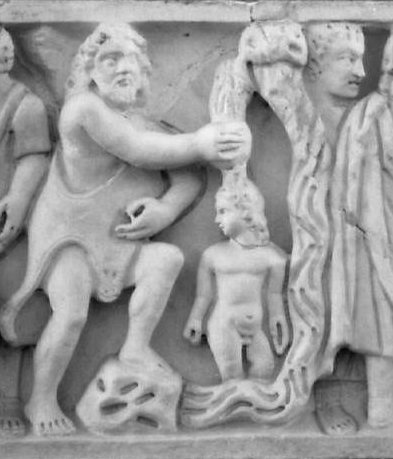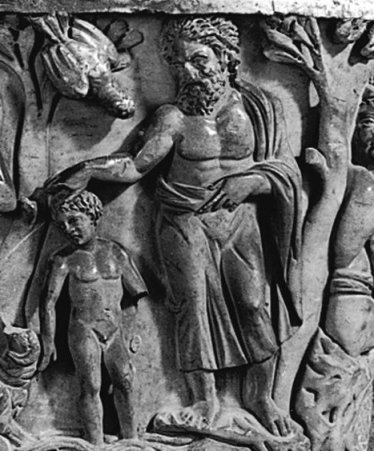|
The Baptisteries |
|
|
Arian Baptistery |
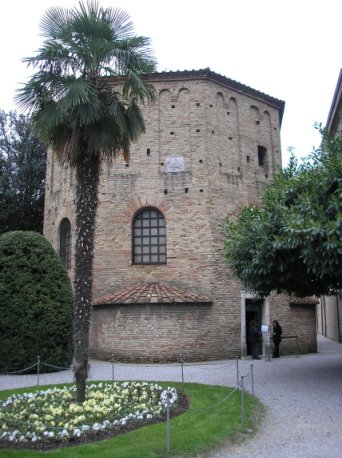 Neonian Baptistery |
History The earliest baptistery is known as the Neonian baptistery after Bishop Neone who completed the dome some time in the middle of the fifth century. It is sometimes, and somewhat confusingly, called the Orthodox baptistery, by which is meant orthodox Catholicism as opposed to Arianism. It is outside the much-rebuilt cathedral of Ravenna. The Arian baptistery is outside the oldest of Theoderic's churches, now known as Spirito Santo. In Theoderic's day it was the church of the Resurrection; after the fall of the Arians it was dedicated to St. Theodore. Ravenna church dedications are never simple and straight-forward. It was built around the beginning of the sixth century. The builders and mosaicists clearly had the Noeonian baptistery in mind. Let's put the dome mosaics side-by-side: |
|
|
|
|
| It is obvious
straight away that the earlier mosaics are far more elaborate, and this
sumptuousness is continued below with stucco painting and
sculpture. The Neonian baptistery has three circles of mosaics:
the baptism of Christ in the centre, a ring of apostles around it, and a
third ring with various symbolic items such as thrones. Let's look at the Apostles first. The Neonian baptistery helpfully names them, though the names aren't that easy to read. Here are Peter and Paul, Neonian to the left, Arian to the right. |
|
|
|
|
| And a close up of Peter from each: | |
|
|
|
| It seems pretty
clear to me that the earlier, Neonian figures are far more life-like and
characterful. The Arian Apostles are stereotyped figures, with
just enough differentiation to allow identification - Peter's white
beard and his key, for instance. Although later, the Arian mosaics seem
to date from an earlier age, though it is clear that the mosaicist of
the Arian baptistery was fully aware of the the other baptistery across
town, and used it as a model. So what's going on here? Before thinking about that, lets now look in more detail at the centre panel. There is an obvious difference and one I've referred to when looking at the Sant'Apollinaire mosaics. |
|
|
|
|
| John the Baptist
is busy baptising Christ, with the assistance of the heavenly dove and a
person usually described as a 'symbolic representation of the River
Jordan' because describing him as a river god would obviously not do at
all. (Though some art historians do.) He is holding a river rush or
reed, and has, in the Arian version, what Giuseppe Bovini describes as
'lobster claws' coming out of his head, which is odd really, as lobsters
don't live in rivers. In the Neonian baptism, Christ is a full-grown, bearded man. In the Arian version he is a young boy. What is the significance of that? There are those that nod their heads wisely and say 'Aha! Arianism! The ageing process in the image of Christ demonstrates his humanity!' But I'm not so sure. The first thing that needs to be said is that there is no biblical authority for Christ being baptised as a young boy. In a purely literal sense, the Neonian version is more accurate. But let's look now at some fourth century sarcophagi with images of the baptism. Remember, there were (and still are) plenty of sarcophagi, Christian and Pagan, in Ravenna. |
|
|
|
|
| On these
sarcophagi, Christ is even younger than in the Arian baptistery. What is
the thinking behind this? The answer must be that we should be thinking of baptism images less as a record of a historical event, and more as a symbol of the rite of baptism. Robin Margaret Jensen in Understanding Early Christian Art, puts it this way: 'The most logical explanation for the diminutive size or child-like appearance of Jesus is that the iconography reveals an aspect of of the rite itself, an aspect also symbolised by the nudity shown in the image - it returns the candidates to the status of children. As newly born, just emerged from the waters of the font, they are like naked babies.' So, rather than a particular theological stance, the images in the Arian baptistery can be seen as a harking back to earlier iconography. Certainly, from that point on all representation of the Baptism show Christ as an adult, and the symbolic use of the image was forgotten. Why was this? No one knows. Maybe the mosaicist was steeped in those early images; maybe the authorities at the church of the Resurrection wanted it that way. What isn't in doubt is that if the image had been defiantly Arian, the later bishops would have made sure that it wouldn't be there for us to see it.
|
|


